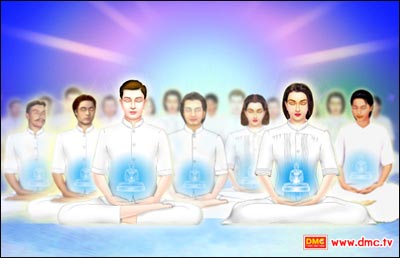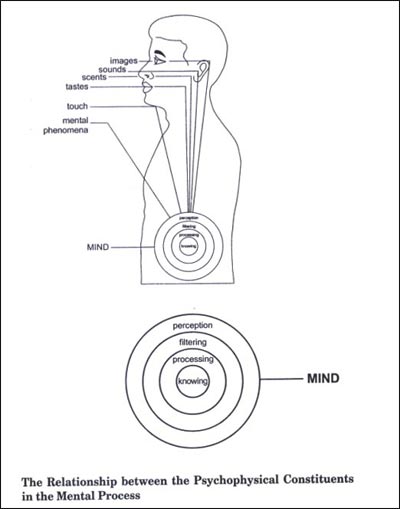The Noble Truth of the Path to
the Cessation of Suffering # 2
For as long as the meditation monk is able to see
7.2 Mindfulness of the Feeling in the Feeling
The mindfulness of the feeling in the feeling is to see and consider the feelings [vedana] both inside and outside, the whole of the time. At a superficial level, mindfulness of the feeling in the feeling is to observe the feelings of happiness, suffering and ‘neither happiness nor suffering’ which occur at the centre of the subtle human body. The feelings of happiness, suffering and ‘neither happiness nor suffering’ manifest themselves in the form of bright spheres at the centre of the subtle human body. If you are still unable to see the subtle human body inside, then it will certainly be impossible for you to observe the spheres of the feelings. You must start by placing your mind in meditation at the centre of your (physical) body. Once the mind becomes settled, the subtle human body will appear. Putting ypur mind at the centre of the subtle human body, you will observe the spheres of the feelings arising there. For our physical body and senses, the feelings which arise foe us are externally based – they are external feelings. By contrast, for the subtle human body, the feelings arise from within – they are internal feelingsa.
Once the meditatior has developed the absorptions to this point not only can they see the inner bodies in succession they will be able to see the corresponding feelings at the same time.
For as long as the meditation monk is able to see and consider the feelings in the feelings continuously and strives to uproot the defilements, by cultivating the ‘mundane’ absorptions, his mind will become ‘cooler’ with the reduction of activity of defilements in the mind. At the same time, the meditator’s knowledge will grow with a thorough awareness. The meditatior will become less prone to forgetfulness, confusion and absent-mindedness, in keeping with the scriptural Pali explanation:
“Atapi sampajano satima”
In this way, the meditator will start to remove from his mind the subtle defilements of covetousness [abhijjha], feeling slighted [domanassa] and ultimately the rest of the fetters [samyojana] too…
The mindfulness of the mind in the mind is to see and consider the mind both inside and outside, the whole of the time.
7.3 Mindfulness of the mind in the Mind
The mindfulness of the mind in the mind is to see and consider the mind both inside and outside, the whole of the time. It is obvious how we can be mindful of the state of the mid. If the mind is mixed up with desires, then you are mindful that ‘ the mind is mixed up with desires’. If the mind is mixed up with hatred, then you are mindful that ‘the mind is mixed up with hatred’. If the mind is free of hatred you are mixed up with hatred’. If the mind is free of hatred you are mindful that ‘the mind is free of hatred’. If the mind is mixed up with delusion, you are mindful that ‘the mind is mixed up with delusion’. If the mind is sleepy, you are mindful that ‘the mind is sleepy’. If the mind is distracted, you are mindful that ‘ the mind is distracted’. If the mind is concentrated, you are mindful that ‘the mind is concentrated’. If the mind is liberated, you are mindful that ‘the mind is liberated’. If the mind is not liberated, you are mindful that ‘the mind is not liberated’.
Less obvious is how we can consider the mind in the mind. What is the nature of the mind? The normal resting point of the mind is at the seventh base of the mind. The mind comprises four concentric layers-the layer of perception, the layer of sensory registration, the layer of central processing and the layer of cognition (see diagram p.127). The outermost layer is the sphere of perception (sometimes called the bodily sphere) and is located at the centred of the body. The next layer in is called the sphere of sensory registration (sometimes called the sphere of the spirit) and is located at the centre of the sphere of perception. The next layer in os the layer of central processing sometimes called the mind sphere) and is located at the centre of the sphere of cognition (sometimes called the sphere of awareness) and is located at the centre of the sphere of central processing.
Our faculties of perception, sensory registration, central processing and cognition can be projected instantaneously to anywhere in the world. In fact what we do when we project our mind is to project our subtle body –something which can be clearly seen by those who have already attained Dhammakaya. If we have attained Dhammakay we will realize at any moment what our subtle body is doing and we will be able to recognize the owner of the subtle body by its appearance.
If you attain the subtle human body it is already twice as wise.
The faculties of perception, sensory registration, central processing and cognition are nested together inseparably and as a unit take the form of the subtle physical body. If the four faculties are separated, the subtle physical body will die immediately-and wihout an intact subtle physical body, the physical body is what we can call 'mindfulness of the mind iutside' The ability to see the mind outside is hard enough for most people-not to speak of seeing the mind inside, which is many times harder.
The most important thing beneath the whole issue of inner bodies is the subject of wisdom, concerning which Luang Phaw Wat Paknam taught:
"If you are able to attain the body of enlightenment (Dhammakaya) you will find that is many tens of times wiser than our human physical body.
If you attain the subtle human body it is already twice as wise.
Attaining the Angelic Body, it is twice as wise again.
Attaining the Subtle Angelic Body, it is four times wiser.
Attaining the Form-Brahma Body, it is four times wiser.
Attaining the subtle Form-Brahma Body, it is five times wiser.
Attaining the Formless-Brahma Body, it is six timer wiser.
Attaining the subtle Formless-Brahma Body, it is seven times wiser
Attaining the Body of Enlightenment and Subtle Body of Enlightenment, they are eight and nine times wiser respectively.
This is the nature of their successive wisdom-you should familiarize yourself with their relative wisdoms."
The Relationship between the Psychophysical Constituents in the Mental Process
When the Buddha tells us to cultivate mindfulness of the mind in the mind, it means mindfulness only of the sphere of central processing and not the spheres of the mind in volved with perception, sensory registration or cognition. It is no use having mindfulness of any other parts of the mental process-because the layers of the mind cannot exchange roles any more than the moon can exchange its role with the sun.
The pure mind [bhavangacitta] has the character of a clear, translucent sphere about the size of the pupil of our eye. However when the mind is tainted with desire which is red in colour, then the mind will become coloured red and will lose its translucence. If it is tainted with ill will which is dark greenish in colour then the mind will become darkened and muddy.
The mind is of the nature of arising and extinguishing the whole of the time-this is how the mind changes.
So how can we manage continuously to cultivate mindfulness of the mind both inside and outside? Cultivating mindfulness of the outer mind is to see the mind of the physical human body, Cultivating mindfulness of the inner mind is to see the mind of the subtle human body and how it changes at any moment – how it arises and extinguishes, arises and extinguishes. Once the meditator is able to observe as described, knowing with clear comprehension the state of the inner mind, he should know it according to reality and feeling of the arising and extinguishing without letting craving [tanha] or views [ditthi] affect how he sees, without attachment to the things of the world, knowing one has no further attachment for the things of the world – this is how we can continuously cultivate mindfulness of the mind in the mind both inside and outside.
Meditation - Related Articles
" />
" />
" />
" />
" />
" />
" />
" />
" />
" />
" />
" />
" />









